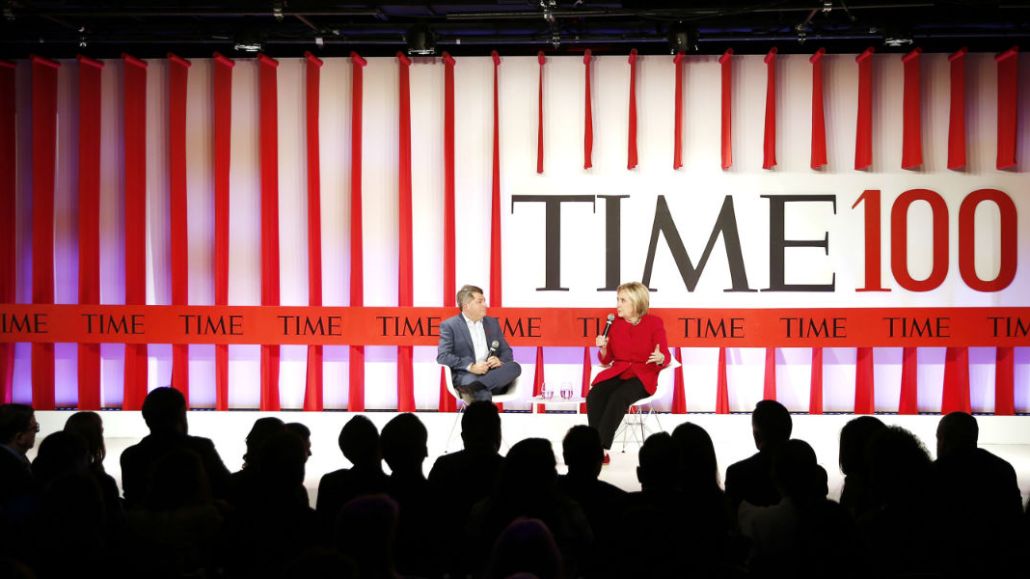‘A blueprint for what is going to happen’: Time’s Time 100 franchise on track to double revenue in 2020

Over the past two years, Time has held high ambitions of expanding its Time 100 awards program from a magazine special and a gala to an events and membership franchise.
But with a global pandemic putting a stop to its in-person summits that it launched in 2019 — the Time 100 Summit, Time 100 Health Summit and the Time 100 Next Summit — that expansion planned seemed destined stall.
Then the legacy magazine brand pivoted to video and broadcast television as a way to not only broaden its audience but deepen the brand deals associated with the franchise. Now Time 100 is outpacing its 2019 revenue by 37%, with the projection that it will double year over year, according to the company.
In April, Time replaced its Time 100 Summit with the Time 100 Talks: a virtual event that has since expanded into a weekly show on Time.com, which now averages 5 million views per episode, according to Dan Macsai, executive editor and editorial director of the Time 100.
In May, Digiday reported that the Talks had brought in $1 million in sponsorship revenue but since then, it has been bringing in the mid-seven sponsorship figures, according to Ian Orefice, president of Time Studios. Financial institutions like Citibank and DBS Bank and insurance providers like State Farm and American Family Insurance have been sponsors for this series.
Continuing to capitalize on the success of the video programming pivot, the publisher is planning to reveal its 2020 class of Time 100 honorees with an hour-long broadcast special that will air in prime time on ABC on September 22. The show will include a mixture of mini-documentaries of the honorees, as well as musical performances and toasts from previous honorees.
Macsai said that the goal is to create a living and breathing community of honorees that continue to contribute to the video programming, both for the broadcast and for the Talks.
“It’s a natural progression for the Time 100 franchise” to go to broadcast programming, said Steven Bloom, managing director of enterprise partnerships at Omnicom Media Group. This is because the level of influence that the honorees have across a variety of industries is unmatched, he said. Some past honorees include actress and the Duchess of Sussex Meghan Markle, President Donald Trump, professional tennis player Naomi Osaka and Oscar-winning actress Brie Larson.
“Moving into broadcast, you’re moving the franchise in front of a much larger audience that wasn’t exposed to it in the past,” he said, making it an even more lucrative opportunity to increase revenue.
Broadcast sponsor, Procter & Gamble, is co-producing and co-financing the show’s production, said Orefice. He declined a request to disclose the revenue earned from this partnership or from licensing the programming to ABC.
Brain Wieser, the global president of business intelligence at GroupM, though, said that an hour-long, prime-time program can fetch upwards of $1 million or more for the publisher.
Time Studios was founded towards the end of 2019 and in just a year is pacing to be a low eight-figure revenue stream in 2020, according to Orefice. In addition to the upcoming broadcast, the studio has also created a number of documentaries and scripted products, some with scheduled theatrical releases.
Wieser said that while this is a new venture for Time as a publisher to enter into broadcast programming, publishers have incrementally been increasing their video divisions and their reach into broadcast for years. Meredith and Hearst now own dozens of their own local television stations, while Condé Nast and Vox Media have created video studios of their own to produce and license out content for their brands in-house.
“Time 100 is a blueprint for what is going to happen with the rest of Time,” said Orefice. For example, later this year, Time for Kids will be following suit by creating a television show for its Kid of the Year franchise that will premiere on Nickelodeon and CBS. “It’s about taking the cornerstone of what has always made this brand great and bringing that to life in new ways,” he said.
More in Media

A timeline of the major deals between publishers and AI tech companies in 2025
Here’s a list of all the major deals signed between publishers and AI tech companies in 2025.

No playbook, just pressure: Publishers eye the rise of agentic browsers
For the bulk of publishers, Google is, as ever, the one to watch. It’s already got agentic features within its Chrome browser, but that’s the tip of the iceberg, some say.

The biggest SEO lessons in 2025 for publishers
KPIs are changing, more AI search data is becoming available, and publishers are looking beyond search to grow their audiences and revenue.








